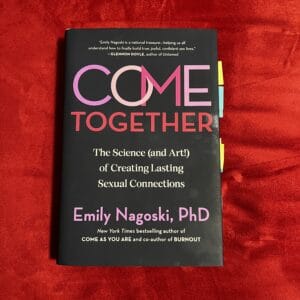Posts Tagged ‘book review’
The Turned-On Couple by Corinne Farago
The Turned-On Couple
by Corinne Farago
Reviewed by Mac Marshall
Corinne Farago
“No matter how dry your sex life is right now, there’s a path forward for you as a couple.” (p.136)
Are you in a long-term marriage or partner relationship? Do you two bicker over small matters and often feel irritated with one another? Has the quality and frequency of your sex life fallen into a rut? If so, Corinne Farago’s book The Turned-On Couple may be just what you need.
In this book, Farago distills her coaching experiences into a self-help guidebook for relationship rejuvenation. She argues that we all crave relationship intimacy, but a couple’s level of intimacy may weaken over time. Honest communication can revive that intimacy. Intimacy in turn builds trust. Trust lets us be vulnerable. Vulnerability allows us to gain self-acceptance and discover our authentic sexual selves. That then frees us to communicate with our partner about what works for us sexually, and why.
Farago seeks to jolt those of us in long-term relationships who may have become “comfortably numb” to our partner. Her goal as a sex coach is to help couples manage problems she finds commonplace in long-term relationships. These include conflict mismanagement, communication difficulties, desire discrepancies, and lackluster sex lives.
The Turned-On Couple is divided into 65 brief chapters, each focused on a specific issue. These are sorted into three major sections, reminiscent of Timothy Leary’s famous counterculture-era phrase, “Turn on, tune in, drop out.” However, Farago wants us just to turn on, not to drop out. The book’s sections are:

- Tune In (28 chapters): “You’ll learn about the essential skills of building a secure and loving foundation for your intimacy to thrive. Use these lessons to guide you and your partner in conversation, and discover how to build new habits in love that support your passion.”
- Turn Up (16 chapters): “We look at the often-mysterious world of desire, how to turn up your own desires, and how to confidently express those desires to your partner….Through practical guidance and reflective exercises, let’s explore how to turn up desire with authenticity, empathy, and vulnerability.”
- Turn On (21 chapters): “We embark on a voyage of exploration, shedding light on the secrets to cultivating a deeply satisfying and fulfilling sexual connection. From communication and vulnerability to pleasure and new adventures, let’s look at the essential elements that pave the way to becoming a Turned-On Couple.”
These chapters range from 2 to 6 pages. Farago has designed the book so that you can read it all the way through from front to back, or you can select particular chapters of interest. Every chapter contains ideas for solving particular problems. These examples convey the flavor of her suggestions:
“When couples learn how to talk about sex from a place of curiosity and playfulness, they realize that sex talk can be fun. Talk about what you like and want more of. Talk about sex after you have sex, and share your highlights. If sex has become boring, you know it’s time to start growing again.” (p.22)
- “In order to maintain mystery in a long-term relationship, you want an ongoing balance of attachment and independence….Find ways of taking space and doing your own thing. See friends, exercise, or start a new sport or hobby that engages you. Differentiate yourself from your partner in healthy ways. Romantic attachment is important to build trust and safety, but creating space from your partner is the necessary ingredient to building desire.” (p.86)
- “In long-term relationships, consent means more than just asking for sex; it’s asking about what kind of sex we want….It’s a conversation about needs and desires. It’s checking in with your partner and ensuring that you both have an opportunity to express an enthusiastic “yes” to what’s being offered, whether that’s a foot massage, intercourse, or something new on the erotic menu.” (p.274)
I have a mild criticism: what is meant by a “long-term relationship” is never specified. Five years? Fifteen years? Fifty years? We’re left to intuit this.
Although not written specifically for seniors, Farago’s focus on long-term relationships makes this book relevant to the many seniors who live in decades-long marriages. Others of us—widowed or divorced—develop what may become lengthy new relationships outside of marriage in our later years. In both circumstances, The Turned-On Couple offers much helpful advice to older adults.
Visit Corinne Farago’s website. Order The Turned-On Couple from your local bookseller, or Bookshop.org (which benefits indie booksellers), or Amazon.
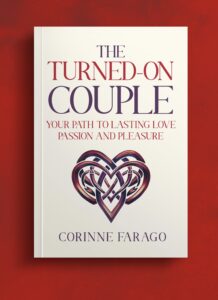

Mac Marshall, PhD is a retired anthropology professor, researcher, and author who is delighted to explore sexuality studies at this time of his life.
LATitude by Vicki Larson
LATitude: How You Can Make a Live Apart Relationship Work
by Vicki Larson
Reviewed by Mac Marshall

Vicki Larson, photo credit Kim Thompson Steel
LAT stands for Live Apart Together. In her welcome book about this new lifestyle, Vicki Larson notes that at least three things must occur for a relationship to be considered LAT:
- Two people agree that they are a committed romantic couple;
- Others view them as a committed romantic couple;
- They intentionally reside in separate homes.
LAT has grown in popularity in recent years, especially among divorced or widowed older adults. Many seniors find that living separately from their romantic partner provides an attractive combination: committed companionship along with personal independence.
 “There are several studies indicating that living apart from your romantic partner benefits your sex life,” says Larson. “LAT couples often experience more passion, idealize their partners more, daydream about their relationship, and report more loving feelings toward their partner than couples who live together.” Larson’s own interviews revealed that compared to couples who live together, LAT couples:
“There are several studies indicating that living apart from your romantic partner benefits your sex life,” says Larson. “LAT couples often experience more passion, idealize their partners more, daydream about their relationship, and report more loving feelings toward their partner than couples who live together.” Larson’s own interviews revealed that compared to couples who live together, LAT couples:
- Have the same or even higher levels of commitment;
- Feel equal or greater trust for their partners;
- Have the same or higher levels of stability;
- Experience equal or more relationship satisfaction.
LAT relationships typically offer a couple equality, intimacy, stability, and more satisfying sex than if they resided under one roof. “Absence not only seems to make the heart grow fonder, it also makes the libido stronger.”
Larson lists the reasons most people state for getting married: love, “lifelong commitment, companionship, children, having the relationship be recognized by a religious ceremony, financial stability, and…legal rights and benefits.” She notes that living together is not mentioned as a reason to wed. Indeed, “all the stated reasons for marrying can be achieved while living apart from your romantic partner.” In LATitude, she presents examples of married couples who actively choose to live apart happily, often for decades.
To succeed in a LAT relationship, you must feel secure in your sexual relationship. “Ultimately, it comes down to this: Are you with someone you trust, and is that person worthy of your trust? And are you someone your partner can trust?” With or without marriage, LAT rests on mutual trust to abide by whatever agreements and boundaries a couple establish, including whether to be monogamous or consensually non-monogamous. Larson quotes a therapist who is in a longtime LAT partnership: “Before you take this step, you have to be really secure in your relationship. The commitment you need in your relationship can’t be half-assed. It takes more trust when you’re not going to see the person and you have no idea what they’re doing all day or night.”
If you are a senior intrigued by or contemplating an LAT relationship, Larson’s book is essential reading. She also addresses financial matters, legal issues, and decisions about caregiving as aging partners require more assistance. These are especially relevant to our age group. You’ll come away from her book with a solid understanding of the pros and cons of LAT as you chart your own course.
Larson’s book is essential reading. She also addresses financial matters, legal issues, and decisions about caregiving as aging partners require more assistance. These are especially relevant to our age group. You’ll come away from her book with a solid understanding of the pros and cons of LAT as you chart your own course.
My own experience: I am 80 years old. I had two long marriages. The first one ended in divorce and the second with my wife’s death. I have no desire to remarry. As a widower I am now in a delightful and fulfilling LAT relationship. I find it satisfying in a host of ways. My partner and I each live in our own home and see one another several times a week, including one or two “overnights.” We communicate daily. We maintain our separate friendship networks, along with friends in common. Sometimes we travel together, sometimes solo. We keep our finances separate and often treat each other to dates or trips. We schedule regular sex dates in advance. The anticipation of such planned intimacy adds to the excitement. Disadvantages to LAT? I can’t think of any!
Do you have a LAT arrangement? I invite you to comment.

Mac Marshall, PhD is a retired anthropology professor, researcher, and author who is delighted to explore sexuality studies at this time of his life.

Purchase LATitude: How You Can Make a Live Apart Relationship Work from Bookshop.org. Visit Vicki Larson’s website.
Come Together by Emily Nagoski

Emily Nagoski at Book Passage, Corte Madera, CA
Come Together: The Science (and Art) of Creating Lasting Sexual Connections
by Emily Nagoski, PhD
Reviewed by Mac Marshall
What is the key to passionate sex over the long term? Frequency? Orgasms? Novelty? Monogamy? Being a “skilled” lover?
Wrong, says Emily Nagoski, PhD in her new book, Come Together: The Science (and Art) of Creating Lasting Sexual Connections. Her goal is to give us the key to long-term satisfying sex. She writes,
Great sex in a long-term relationship is not about how much you desire sex or how often you have to do it. It’s not about what you do, in which position, with whom or where or in what clothes, even how many orgasms you have. It’s whether or not you like the sex you are having.
“Pleasure Is the Measure” is a major theme of Come Together. Pleasure is all about “how much you like the sex you’re having.” Most of the book teaches how to create access to pleasure with a long-term partner. Mutual admiration and trust are essential to this creative process.
Most of us seek both connection and pleasure in sexual relationships. But the excitement we feel when a relationship begins often fades as time goes by. Partners in committed relationships such as marriage frequently drift apart sexually. Typically, this is due to work pressures, the demands of family, and our physical changes as we age. Nagoski gives us helpful guidelines to revive and maintain connection and pleasure for the long haul.
haul.
Two chapters focus on what she calls “your emotional floorplan.” She bases this on the dual control model that she introduced in her best-known book, Come As You Are: turn-ons—the accelerator—and turn-offs—the brakes. The floorplan consists of seven emotional spaces that affect your sexuality: lust, care, play, rage, panic+grief, fear and seeking. She offers advice on how to navigate these emotional states as we construct a safe space with our partner for mutual sexual pleasure.
When people “come together” in partnerships Nagoski finds they seek:
- connection,
- shared pleasure,
- being wanted by another,
- freedom to feel full immersion in an erotic moment.
These are especially pertinent for relationships between seniors. Aging usually changes our needs for erotic connection. It is potentially empowering. For example, Nagoski observes:
[Aging provides] a context that encourages you to explore. Try new things. Shed all the preconceived ideas about how sex “should” work and experiment with all the ways it can and does work for you and your partners, in the bodies you have right now.
Come Together centers on persons of any gender in long-term relationships. She shows us ways to create partnerships that sustain a strong sexual connection. The partnership characteristics she focuses on are:
- they are friends
- they prioritize sex
- they pursue what’s genuinely true for them—what works in their unique relationship—rather than accepting other people’s opinions about how they’re supposed to do sex.

These characteristics flourish by avoiding “the desire imperative” and “the sex imperatives”:
- “The desire imperative” is the notion that we should feel a “spark” of spontaneous craving for sexual intimacy when a relationship begins. And if we don’t continue to feel that sparky desire, we’ve failed. The desire imperative pooh-poohs planning or preparing for sex, and if we and our partner don’t just spontaneously want each other effortlessly, we must not want each other enough. Against this “mess of wrongheadedness,” Nagoski centers pleasure as the alternative measure of sexual well-being.
- “The sex imperatives” that endanger lasting sexual connections are many, including these:
- the coital imperative (penis-in-vagina sex)
- the variety imperative (manual, oral, and anal play as well as PIV)
- the performance imperative (enhancing your sexual skill set)
- the monogamy imperative (you should only have one sexual relationship at a time)

Fixation on any or all of these can thwart success in building lasting sexual connections.
Change is an unavoidable given in life and relationships. Among the changes most of us encounter are illness, pain, and aging. Nagoski writes,
The key to sustaining a strong sexual connection over the long term is to adapt—with confidence, joy, and calm, warm curiosity—to the changes brought by each season of our lives.
To join together in a successful sexually rewarding long-term partnership, Nagoski champions trust, admiration, confidence and joy. She gives these tips for achieving mutual lasting pleasure and connection:
- Seek authenticity.
- Plan for and embrace the changes that will always occur.
- Find adaptations and adjustments that work for your unique situation.
Just as Nagoski’s Come as You Are is a ground-breaking book for women understanding their sexuality and achieving sexual pleasure, Come Together is the book you need to enrich the sexual joy in a long-term relationship. Read it — your sexual relationship will thank you!
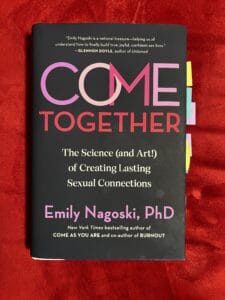
Purchase Come Together at your local independent bookstore or order from Bookshop.org or Amazon.

Mac Marshall, PhD is a retired anthropology professor, researcher, and author who is delighted to explore sexuality studies at this time of his life.
Interview with Ann Anderson Evans, author of The Sweet Pain of Being Alive
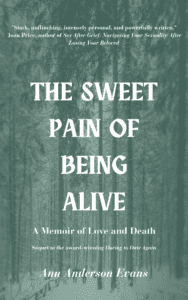
I never worried that Terry would leave me. Having married in our sixties, we felt we’d captured an unexpected shower of fairy dust. For all our fourteen years together, we frequently joined hands for a warm, smiling moment. We were so lucky to have each other!
But one night, he did leave me. He placed a plastic bag over his head. The thin kind used to bag vegetables in the grocery store.
So begins The Sweet Pain of Being Alive: A Memoir of Love and Death by Ann Anderson Evans. Why did her husband Terry die?
“People are not always, maybe not ever, what they seem,” writes Evans. In The Sweet Pain of Being Alive, she unravels Terry’s pain and expands her own understanding of gender identity, shame, marriage, and the facades we build.
Evans was willing to share some thoughts with us here:
Q: Ann, The Sweet Pain of Being Alive, deals with the death of someone you loved who had a secret. Why was it important for you to reveal what Terry had kept hidden?
 I wanted to honor what Terry had gone through as it became clear, after his death, that he yearned to be a woman. “Imagine what it took just for him to get through every day,” one person told me.
I wanted to honor what Terry had gone through as it became clear, after his death, that he yearned to be a woman. “Imagine what it took just for him to get through every day,” one person told me.
The secrecy around his gender dysphoria contributed to his suicide, and I refuse to keep this toxic secret. I want to lend my voice in support of people, especially those of my generation, who feel they must hide who they are.
Q: What did you understand about Terry’s gender dysphoria while you lived together?
There were many signs, but I didn’t know what I was looking at. I was shocked when I found a box of women’s clothes under the bed, for example, but didn’t know what to make of it. He also didn’t have the kind of sexual drive men usually have. But he was so much more than sex for me that I was willing to adjust to that, without realizing it was a symptom of dysphoria.
Q: This was more than cross-dressing. You say he wanted to be a woman, yet he kept that secret, even from you. How far do you think he wanted to go?
Terry didn’t realize how much transition would entail. Just wearing women’s clothes is barely a beginning. He would have to learn how to dress, do his hair, walk, and laugh. Men pretty much walk where they please. Women don’t. He’d have to develop the protective sense that women have as they move through the world. This is difficult choreography. He knew he would likely lose a lot, possibly including a job he loved and even his marriage, Maybe he didn’t want to risk that.
Q: What do you understand now that you didn’t before?
 Terry never sat me down and said, “Ann, either I die or you become a lesbian,” but if he had, I think I would have tried to adjust, though I’m not sexually attracted to women. His transition would have required me to make deep changes in myself that I had not agreed to. I don’t know how that would have played out. I had not calculated the demands of transition on the person’s partner.
Terry never sat me down and said, “Ann, either I die or you become a lesbian,” but if he had, I think I would have tried to adjust, though I’m not sexually attracted to women. His transition would have required me to make deep changes in myself that I had not agreed to. I don’t know how that would have played out. I had not calculated the demands of transition on the person’s partner.
All the transgender people I know have been uncomfortable in their body from childhood. It is a condition as old as humanity. The challenge is not for them to pretend they are as we want them to be, but it is for us to make space for them. The acceptance of gay marriage and other deep societal changes prove that this can be done.
In my experience, there is a refreshing insouciance to transgender women. They’ve been raised as boys, had their fights in the schoolyard, been in the competitive locker rooms, carried expectations of professional achievement. They have an often humorous sense of the arbitrariness of many of our cultural habits. If we started out with the attitude that “Every member of the tribe counts,” then transgender people would be free to create roles that we have never imagined.
Q: How are you now?
Suicide is very common, yet the shock of it doesn’t wear off easily. There is an element of betrayal—a loved one has abandoned you.
Every death is unique and revisits every grieving person differently and in its own time. Three and a half years after Terry’s death, I sometimes feel untethered, left behind. This may be true of people whose loss does not include suicide, but in my heart, it is connected.
Joan, as you write in your book, Sex After Grief, widows and widowers are vulnerable for quite a while after their loss. We can be struck out of the blue. My special kind of loneliness is reliving of a situation where I thought I knew where I was, but it was just an illusion.
I have learned that suicide has its own agenda, unrelated to the gender dysphoria, and I do not feel responsible for his death. I know that he never for one minute had occasion to doubt my love for him, and I never doubted his love for me. We both did our best, and I don’t say that lightly. We took the best care we could of each other every day.
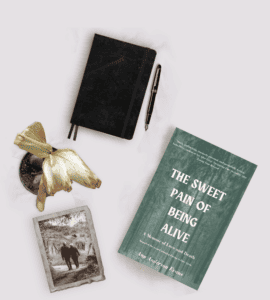
Purchase The Sweet Pain of Being Alive: A Memoir of Love and Death from Bookshop.org or Amazon. Learn more about Ann Anderson Evans at https://annandersonevans.com/.


